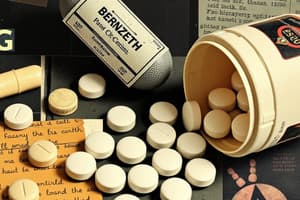Podcast
Questions and Answers
What is the result of exogenous agonists such as benzodiazepines on the receptor-effector system?
What is the result of exogenous agonists such as benzodiazepines on the receptor-effector system?
- Excitation and neural stimulation
- Sedation and GABA-like inhibition (correct)
- Anxiety and inhibition
- Muscle relaxation and blockade
What is the mechanism by which drugs can move into or out of cells?
What is the mechanism by which drugs can move into or out of cells?
- Passive diffusion through aqueous channels
- Active transport by carriers
- Endocytosis and binding to cell surface receptors
- All of the above (correct)
What is the purpose of administering a drug into a specific body compartment, such as the gut?
What is the purpose of administering a drug into a specific body compartment, such as the gut?
- To ensure rapid distribution to the site of action
- To facilitate absorption into the blood (correct)
- To minimize the risk of toxicity
- To maximize the therapeutic effect
What is the effect of inverse agonists on the receptor-effector system?
What is the effect of inverse agonists on the receptor-effector system?
What is the mechanism by which flumazenil blocks the effect of benzodiazepines?
What is the mechanism by which flumazenil blocks the effect of benzodiazepines?
What is the role of the bloodstream in the distribution of a drug?
What is the role of the bloodstream in the distribution of a drug?
What is the primary characteristic of an inverse agonist?
What is the primary characteristic of an inverse agonist?
What is the purpose of a prodrug?
What is the purpose of a prodrug?
What is the primary goal of pharmacokinetics in therapeutics?
What is the primary goal of pharmacokinetics in therapeutics?
What is the result of a drug having a much stronger affinity for the Ri state than for the Ra state?
What is the result of a drug having a much stronger affinity for the Ri state than for the Ra state?
What is the term for the process of converting an inactive precursor into an active drug?
What is the term for the process of converting an inactive precursor into an active drug?
What is an example of a direct route of administration?
What is an example of a direct route of administration?
What is the term for the receptor-effector system that is activated by the endogenous transmitter GABA?
What is the term for the receptor-effector system that is activated by the endogenous transmitter GABA?
What is the result of a drug stabilizing a large fraction of receptors in the Ri state?
What is the result of a drug stabilizing a large fraction of receptors in the Ri state?
Which of the following drugs is a Schedule I controlled substance?
Which of the following drugs is a Schedule I controlled substance?
What is the main difference between Schedule II and Schedule III controlled substances?
What is the main difference between Schedule II and Schedule III controlled substances?
Which of the following opioids is a Schedule III controlled substance?
Which of the following opioids is a Schedule III controlled substance?
What is the primary purpose of the scheduling system for controlled substances?
What is the primary purpose of the scheduling system for controlled substances?
Which of the following is NOT a Schedule IV controlled substance?
Which of the following is NOT a Schedule IV controlled substance?
Which of the following drugs is a Schedule V controlled substance?
Which of the following drugs is a Schedule V controlled substance?
What is the main difference between Schedule II and Schedule III opioids?
What is the main difference between Schedule II and Schedule III opioids?
Which of the following drugs is a cannabinoid?
Which of the following drugs is a cannabinoid?
What is the purpose of the prescription requirements for Schedule II controlled substances?
What is the purpose of the prescription requirements for Schedule II controlled substances?
Which of the following is a characteristic of Schedule I controlled substances?
Which of the following is a characteristic of Schedule I controlled substances?
Flashcards are hidden until you start studying
Study Notes
Drug Administration and Pharmacokinetics
- Administering a drug into one body compartment (e.g., the gut) requires it to move to its site of action in another compartment (e.g., the brain) via absorption into the blood and distribution to the target site.
- The drug must permeate through various barriers, such as aqueous channels, lipid cell membranes, and cell surface receptors.
Mechanisms of Drug Permeation
- Passive diffusion through aqueous channels in intercellular junctions (e.g., tight junctions)
- Diffusion through lipid cell membranes
- Carrier-mediated transport into or out of cells
- Endocytosis and binding to cell surface receptors
Pharmacokinetic Principles
- A drug's ability to reach its intended site of action after administration is critical in practical therapeutics.
- The active drug molecule may be administered as such, or an inactive precursor chemical (prodrug) may be given, which is converted to the active drug by biologic processes inside the body.
- In some cases, a drug can be applied directly to the target tissue, such as topical application of an anti-inflammatory agent to inflamed skin or mucous membrane.
Drug Receptor Interactions
- Exogenous agonists, like benzodiazepines, facilitate the receptor-effector system and cause GABA-like inhibition, resulting in sedation as the therapeutic effect.
- Conventional antagonists, like flumazenil, can block this inhibition.
- Inverse agonists, which have a higher affinity for the Ri form, can reduce constitutive activity and produce a contrasting physiologic result.
- The γ-aminobutyric acid (GABAA) receptor-effector system, a chloride channel in the nervous system, is activated by the endogenous transmitter GABA and causes inhibition of postsynaptic cells.
Schedules of Controlled Drugs
- Schedule I: drugs with high abuse potential, no accepted medical use, and lack of safety for use under medical supervision (e.g., heroin, LSD, marijuana)
- Schedule II: drugs with high abuse potential, accepted medical use, but severe restrictions on use (e.g., opioids, stimulants, depressants)
- Schedule III: drugs with moderate to low abuse potential, accepted medical use, and moderate restrictions on use (e.g., anabolic steroids, opioids, stimulants)
- Schedule IV: drugs with low abuse potential, accepted medical use, and limited restrictions on use (e.g., benzodiazepines, opioids, stimulants)
- Schedule V: drugs with low abuse potential, accepted medical use, and minimal restrictions on use (e.g., codeine, difenoxin, pregabalin)
Studying That Suits You
Use AI to generate personalized quizzes and flashcards to suit your learning preferences.




